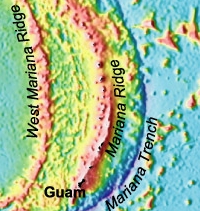Subduction gets a new face

Mantle slab model of rollback and return flow of a subducting slab (Schellart et al., 2007 Nature, London copyright)
Today's Nature (link requires subscription) has an interesting article on the nature of subduction zones and their evolution. Subduction is the process where denser and older oceanic crust is recycled back into the mantle. As the crust is recycled, it also pulls the accompanying plate and provides part of the driving force for plate tectonics. What is interesting about the study published in Nature is that it moves us away from a typical 'cartoonish' view of subduction to a more sophisticated view involving time/space evolution of the subduction zones. A bit of an explanation is needed before delving into the specifics of this new study. Here is a textbook picture of a subduction zone:
The above picture shows the descending oceanic lithosphere penetrating the mantle and going down into the mantle. The picture also shows a long trench intersection with the surface and the depth to which the slab penetrates is not shown. We've known for some time that this simplified picture is not going to give us tremendous detailed insight into the process of subduction or how it affects the mantle or surface features of the earth. We know for example that a slab intersecting the surface of a sphere will create an arcuate shape (Marianas Arc is shown below) and cartoon showing the arcuate shape formed during subduction, but not necessarily how that arcuate shape will evolve through time or whether it should be nearly linear concave or convex. We also do not know how the shape should change with time as the slab interacts with the mantle.

Marianas Arc in the South Pacific formed by the intersection of a linear slab with the curved surface of the earth

Click on Figure for Larger view. Note arcuate shape on right hand side.
The problem has come in modeling the evolution (time/space) of a subduction zone. Subduction does not continue forever. Oceanic plates disappear, the mantle changes density with depth, plates vary in size, slabs vary in width and trenches don't continue on forever. Therefore in trying to look at the time/space evolution of the subduction process, mathematical modelers have been forced to place artificial limits on the process in order to gain insight into subduction. Previous models simplify the subduction zone by doing one of two things. In order to gain information on the temporal sequence of events, they treat the slab as infinite in extent (no end). In order to obtain information about the geometry of the slab, they treat the slab as finite, but fixed in space. Neither treatment allows us to gain full insight into the process of subduction which varies in time and 3-D space. That's what is new with the model published today in Nature.
Schellart et al. model the subduction process as a 3-D variable slab that changes as the subduction geometries change and as the slab encounters different forces during subduction. Their model explains two key features associated with the real earth. They show that slab width constrains the curvature of subduction zones and their tendency to retreat backwards through time (trench migration). Very narrow plates have a concave boundary and retreat much more quickly than wide plates. Wider plates develop a convex boundary and retreat more slowly. It's the very largest subduction zones that are the most intriguing because the models show that the middle regions can actually advance over short time periods rather than retreat. It's that last part that is quite interesting because the Nazca plate is diving beneath South America and there is a feature in the Andes called the Peru-Chile orocline (or bend; see below):

Peru-Chile trench, note the bend in the in the trench (dark blue area that parallels the Andean coastline). The so-called stagnation zone (see figure below) and variable retreat velocity formed the orocline. Mantle flow at either end of the subducting slab changes the velocity of edges of the slab.
The idea put forth in this paper suggests that the advancing zone of the trench is responsible for the apparent indentation in the Peru-Bolivia region of the South American plate. The evolving geometry of the trench is shown in the figure below courtesy of the article in Nature:

Evolution of a Nazca-type trench according to Schellart et al. (2007). Copyright Nature London (2007). The mantle return flow around the edges correspond with the Caribbean region to the north and the Scotia arc to the south.
The model accurately predicts the shapes of various subduction zones around the globe based on the 3-D geometry of the subducting slab. A very nice little study with bearings on real earth processes (and all in the millions of years timeframe) :)
Cheers
Joe Meert


1 Comments:
thanks for the help, im a geology student from greece doing a small paper on tethyan oceans and the text was simple and enlightening. thanks again, hammers up
Post a Comment
<< Home